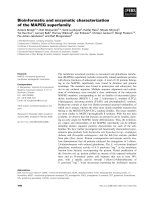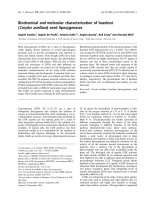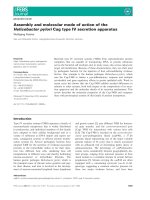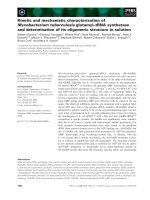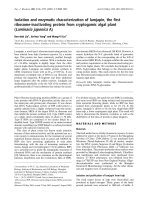Báo cáo sinh học: "Cytogenetic and molecular characterization of eight new reciprocal translocations in the pig species. Estimation of their incidence in French populations" pot
Bạn đang xem bản rút gọn của tài liệu. Xem và tải ngay bản đầy đủ của tài liệu tại đây (141.25 KB, 18 trang )
Genet. Sel. Evol. 34 (2002) 389–406
389
© INRA, EDP Sciences, 2002
DOI: 10.1051/gse:2002014
Original article
Cytogenetic and molecular
characterization of eight new reciprocal
translocations in the pig species.
Estimation of their incidence in French
populations
Alain D
UCOS
a∗
, Alain P
INTON
a
,
Martine Y
ERLE
b
, Anne S
ÉGUÉLA
a
, Hélène-Marie B
ERLAND
a
,
Corinne B
RUN
-B
ARONNAT
a
, Nathalie B
ONNET
a
,RolandD
ARRÉ
a
a
UMR INRA-ENVT de cytogénétique des populations animales,
École nationale vétérinaire de Toulouse,
23 Chemin des capelles, 31076 Toulouse Cedex 3, France
b
Institut national de la recherche agronomique, Laboratoire de génétique cellulaire,
Auzeville BP 27, 31326 Castanet-Tolosan Cedex, France
(Received 25 October 2001; accepted 20 December 2001)
Abstract – Eight new cases of reciprocal translocation in the domestic pig are described. All
the rearrangements were highlighted using GTG banding techniques. Chromosome painting
experiments were also carriedout to confirm the proposed hypothesesand to accurately locatethe
breakpoints. Threetranslocations, rcp(4;6)(q21;p14), rcp(2;6)(p17;q27) andrcp(5;17)(p12;q13)
were found in boars siring small litters (8.3 and 7 .4 piglets born alive per litter, on aver-
age, for translocations 2/6 and 5/17, respectively). The remaining five, rcp(5;8)(p12;q21),
rcp(15;17)(q24;q21), rcp(7;8)(q24;p21), rcp(5;8)(p11;p23) and rcp(3;15)(q27;q13) were iden-
tified in young boars controlled before entering reproduction. A decrease in prolificacy of 22%
was estimated for the 3/15 translocation after reproduction of the boar carrier. A parental origin
by inheritance of the translocation was established for the ( 5;8)(p11;p23) translocation. The
overall incidence of reciprocal translocations in the French pig populations over the 2000/2001
period was estimated (0.34%).
chromosome / reciprocal translocation / pig / reproductive performance / chromosome
painting
∗
Correspondence and reprints
E-mail:
390 A. Ducos et al.
1. INTRODUCTION
Structural chromosomal abnormalities have long been studied in the pig
species. The first one was identified and described almost 40 years ago [14].
Control programmes were initiated in several European countries as early as
the beginning of the 1970’s. Based on karyotypic analyses of hypoprolific
boars detected using national herd management databases [19], t hey led to
the discovery of numerous chromosomal rearrangements, mainly reciprocal
translocations [4,8]. The continuous improvement of chromosome banding
techniques [27] made it possible, during the last decade, to identify and
characterize new rearrangements modifying very slightly the morphology
and/or the banding profile of the chromosomes. One hundred or so structural
chromosomal abnormalities have been published so far [4,10]. In France, the
very important development of artificial insemination (AI) since the end of the
1980’s [12] hasresulted in an intensification of the control programmes, andin a
drastic modification of their structure [10]. Presently, about 90% ofthe analyses
carried out in our laboratory concern young purebred boars controlled before
reproduction (mainly AI) on the selection and multiplication levels (animals
with high diffusion potentials). The chromosomal control of hypoprolific boars
has been maintained, but the detection methods of such animals have evolved
(use of the new information system built for BLUP-animal model indexation
purposes [32], decentralization of the detectionprocedures). Nine new chromo-
somal rearrangements were detected within these control activities during the
January 2000 to June 2001 period, including one pericentric inversion (analysis
in progress) and eight reciprocal translocations described in this paper.
2. MATERIALS AND METHODS
2.1. Animals
Between January 2000 and June 2001, 1730 chromosomal analyses were
carried out in our laboratory in the pig species. Most of them (1 450) correspon-
ded to young phenotypically normal purebred boars controlled independently
before reproduction. The remaining 280 concerned hypoprolific boars, as well
as relatives of animals carryingchromosomal rearrangements ( family analyses).
The main characteristics of the animals carrying reciprocal translocations
are presented in Table I.
2.2. Cytogenetical analyses
The mitotic chromosomes of the translocated pigs and their relatives were
prepared from non-synchronized cultures of peripheral blood lymphocytes.
Whole blood (0.5 mL) was cultured during 72 h in a medium consisting of
Reciprocal translocations in pigs 391
Table I. Chronological list of the cases studied. Main characteristics of the carrier animals.
Case N
◦
Date Breed Reason of control Rearrangement Familial analyses carried out
1 January 2000 Piétrain Boar siring small
litters
rcp(4;6)(q21;p14) none
2 January 2000 Large White Candidate for
reproduction
rcp(5;8)(p12;q21) sire + one sister
3 March 2000 French Landrace
(FL)
Candidate for
reproduction
rcp(15;17)(q24;q21) dam + one sister + one
maternal half-sib (sire
controlled earlier)
4 June 2000 Crossbred (3/4FL;
1/4 Meishan)
Candidate for
reproduction
rcp(7;8)(q24;p21) dam + one full-sib (purebred
FL paternal grand-sire
controlled earlier)
5 October 2000 Yorkshire Boar siring small
litters
rcp(2;6)(p17;q27) none
6 October 2000 Yorkshire Boar siring small
litters
rcp(5;17)(p12;q13) none
7 November 2000 Sino-European
synthetic line
Candidate for
reproduction
rcp(5;8)(p11;p23) 6 full- and half-sibs
8 February 2001 Large White Candidate for
reproduction
rcp(3;15)(q27;q13) offspring (analyses in progress)
392 A. Ducos et al.
10 mL TC199 (Gibco), 20% autologous serum, 500 UI Heparin (Sanofi) and
stimulated with 0.2 mL Pokeweed Mitogen (Gibco). Hypotonic treatment
(10 mL 1/6 calf serum) was followed by pre-fixation and fixation in eth-
anol:acetic acid (3:1). Chromosome preparations were spread on cold wet
slides and air dried. Slides were treated with 0.1% Trypsin (Difco) and stained
with 3% Giemsa solution to generate GTG-banding [30]. Chromosomes were
arranged according t o the standardized karyotype of the domestic pig [6]. At
least 10 metaphases were karyotyped in each case.
Dual-color chromosome painting was carried out, except for case 3 (no
chromosomal material was kept), to confirm the hypotheses put forward as
a result of the banding techniques. Chromosome-specific painting probes
were produced using DOP-PCR amplification [31] of flow sorted L52 swine
chromosomes [29,33]. Fluorescence in situ hybridization was performed
according to [33]. Biotinylated probes were detected using avidin conjug-
ated to Texas Red and amplified using goat biotinylated anti-avidin antibody.
The digoxygenin-labeled probes were detected with sheep anti-digoxygenin
antibody conjugated to FITC (all detection products were from Vector Labor-
atories). The chromosomes were counterstained with DAPI, and the slides
were mounted in an antifade solution. Digital images were obtained using
a Zeiss Axiophot epifluorescence microscope coupled to a CCD camera. A
Cytovision workstation (Applied Imaging) was used for camera control, image
acquisition, pseudocolored image merging and image treatment.
3. RESULTS
3.1. Cytogenetical analyses
Case 1 – A careful analysis of the boar’s metaphases allowed us to identify
relatively easily a rearranged chromosome 6 exhibiting abnormally long p-
arms (Fig. 1a). A rearranged chromosome 4 lacking its q-terminal region was
then pointed out when carrying out the karyotypes. The fragment (4q21 →
4qter) was found without ambiguity at the extremity of the short arms of the
chromosome der(6). The reciprocity ofthe translocation could be demonstrated
very clearly using the chromosome painting approach (Fig. 1b), but it was
difficult to prove using banding techniques only, due to the very small size of
the chromosome fragment translocated from chromosome 6 to chromosome
der(4). The chromosomal rearrangement could be described, according to the
standard nomenclature, as 38,XY,rcp(4;6)(q21;p14).
Case 2 – This rearrangement was much more difficult to identify than
the previous one. A long metaphasic abnormal chromosome was initially
observed. A thorough examination led us to hypothesize that this chromosome
was a rearranged chromosome 5 whose p-arms were almost entirely replaced
Reciprocal translocations in pigs 393
Figure 1. rcp(4;6)(q21;p14)
a) GTG-banding karyotype: the normal chromosomes are on the left, the rearranged chromosomes on the right; the locations of the
breakpoints are indicated by arrows.
b) Dual-color chromosome painting: metaphase spread of a pig heterozygous carrier of the rearrangement.
394 A. Ducos et al.
(breakpoint near the centromere, in the 5p12 band) by the main part of the long
arms of one chromosome 8 (8q21 → 8qter). Reciprocally, the (5p12 → 5pter)
fragment, representingabout 90%of thechromosome 5p-arms,was foundat the
extremity of the der(8) chromosome (Fig. 2a). The chromosome painting ana-
lyses carried out in this case (Fig. 2b) clearly confirmed this interpretation. The
chromosomal rearrangement could be described as 38,XY,rcp(5;8)(p12;q21).
Case 3 – This rearrangement, like the previous one, altered the chromosome
morphologies very slightly. The most visible modification was the abnormal
dark band at the extremity of one (rearranged) chromosome 17 (Fig. 3). The
identification of the second chromosome pair involved in the rearrangement
was more difficult. Nevertheless, the realization of 10 karyotypes allowed
us to identify an abnormally long light band (corresponding to the 17q21 →
17qter fragment) at the terminal extremity of one rearranged chromosome 15,
and the concomitant lack of the very characteristic 15q25 band (15q24 →
15qter fragment translocated to the der(17) chromosome). The chromosomal
rearrangement could be described as 38,XY,rcp(15;17)(q24;q21).
Case 4 – The absence of the characteristic fine dark band at the extremity of
the q-arms of one chromosome 7 was rapidly detected (Fig. 4a). However, as
in the previous case, the identification of the second chromosome pair involved
in the rearrangement (pair 8) was much more difficult. The hypothesis of
breakpoints located in the 7q24 and 8p21 bands, as well as the reciprocity of
the chromosomal exchange, could be confirmed using chromosome painting
techniques (Fig. 4b). The chromosomal rearrangement could be described as
38,XY,rcp(7;8)(q24;p21).
Case 5 – The analysis of the animal’s metaphases revealed a long almost
symmetrical, metacentric abnormal chromosome, looking like an isochromo-
some 2q (Fig. 5a). However, a chromosome 6 truncated in its q-terminal
region was rapidly identified, the missing fragment (6q27 → 6qter) being
observed at the extremity of the p-arms of one rearranged chromosome 2.
The reciprocity of the chromosomal exchange could be demonstrated using
chromosome painting (Fig. 5b). The chromosomal rearrangement could be
described as 38,XY,rcp(2;6)(p17;q27).
Case 6 – The very small sizedrearranged chromosome 17was easilydetected
on the animal’s metaphases ( Fig. 6a). An abnormal grey band was subsequently
identified at the extremity of the p-arms of one rearranged chromosome 5. The
difference between the normal and rearranged chromosome 5 was relatively
fine. The hypothesis that the breaks occurred near the centromere on both
chromosomes, in the 5p12 and 17q12 bands, respectively, was verified by
chromosome painting (Fig. 6b). The residual centromeric chromosome 17
fragment on the der(17) chromosome appeared as not stained by the painting
probe used (there was no green signal near the centromere). The presence of
two small yellow dots at the breakpoint on this rearranged chromosome proved
Reciprocal translocations in pigs 395
Figure 2. rcp(5;8)(p12;q21)
a) GTG-banding karyotype: the normal chromosomes are on the left, the rearranged chromosomes on the right; the locations of the
breakpoints are indicated by arrows.
b) Dual-color chromosome painting: metaphase spread of a pig heterozygous carrier of the rearrangement.
396 A. Ducos et al.
Figure 3. rcp(15;17)(q24;q21)
a) GTG-banding karyotype: the normal chromosomes are on the left, the rearranged
chromosomes on the right; the locations of the breakpoints are indicated by arrows.
the presence of chromosome 17 material and helped to demonstrate t he origin
of the unstained centromeric region of chromosome 17. The chromosomal
rearrangement could be described as 38,XY,rcp(5;17)(p12;q12).
Case 7 – A rapid examination of the animal’s metaphases gave us the
impression that we were faced with a trisomy 10 (Fig. 7a). However, a more
thorough analysisrevealed that the chromosome consideredas a supernumerary
chromosome 10 was in fact a rearranged chromosome 5 lacking its short
arms (breakpoint in 5p11). The corresponding fragment (5p11 → 5pter)
appeared as a p-terminal band on chromosome der(8). The reciprocity of
the chromosomal exchange could not be proved using banding techniques
only, due to the very small size of the chromosome fragment translocated
from chromosome 8 to chromosome 5. Conversely, the chromosome painting
experiments (Fig. 7b) revealed thepresence of a very thin p-terminal green band
on the der(5) chromosome, demonstrating the reciprocity of the exchange, and
allowed an accurate localization of the breakpoint on the p-terminal extremity
of chromosome 8 (8p23 band). The chromosomal rearrangement could be
described as 38,XY,rcp(5;8)(p11;p23).
Case 8 – This abnormality was easily identified due to the presence of
two very particular rearranged chromosomes (Fig. 8a). The first one, the
smallest of the karyotype, corresponded to the chromosome der(15), whereas
the second one, much longer and comparable in size to a chromosome 1,
corresponded to the chromosome der(3). The main part of one chromosome 15
Reciprocal translocations in pigs 397
Figure 4. rcp(7;8)(q24;p21)
a) GTG-banding karyotype: the normal chromosomes are on the left, the rearranged chromosomes on the right; the locations of the
breakpoints are indicated by arrows.
b) Dual-color chromosome painting: metaphase spread of a pig heterozygous carrier of the rearrangement.
398 A. Ducos et al.
Figure 5. rcp(2;6)(p17;q27)
a) GTG-banding karyotype: the normal chromosomes are on the left, the rearranged chromosomes on the right; the locations of the
breakpoints are indicated by arrows.
b) Dual-color chromosome painting: metaphase spread of a pig heterozygous carrier of the rearrangement.
Reciprocal translocations in pigs 399
Figure 6. rcp(5;17)(p12;q13)
a) GTG-banding karyotype: the normal chromosomes are on the left, the rearranged chromosomes on the right; the locations of the
breakpoints are indicated by arrows.
b) Dual-color chromosome painting: metaphase spread of a pig heterozygous carrier of the rearrangement.
400 A. Ducos et al.
Figure 7. rcp(5;8)(p11;p23)
a) GTG-banding karyotype: the normal chromosomes are on the left, the rearranged chromosomes on the right; the locations of the
breakpoints are indicated by arrows.
b) Dual-color chromosome painting: metaphase spread of a pig heterozygous carrier of the rearrangement.
Reciprocal translocations in pigs 401
Figure 8. rcp(3;15)(q27;q13)
a) GTG-banding karyotype: the normal chromosomes are on the left, the rearranged chromosomes on the right; the locations of the
breakpoints are indicated by arrows.
b) Dual-color chromosome painting: metaphase spread of a pig heterozygous carrier of the rearrangement.
402 A. Ducos et al.
(15q13 → 15qter fragment, presenting a very characteristic banding pattern)
appeared translocated to the q-terminal extremity of one chromosome 3. As
for the previous case, the reciprocity of the exchange was very difficult
to prove using the banding techniques, but, once again, the demonstration
could be done using chromosome painting. In Figure 8b we observed one
normal chromosome 15 in green, as well as one normal chromosome 3 in
red. The long dual-colored chromosome was the chromosome der(3). The
small red-colored chromosome corresponded to chromosome der(15). As
for case 6, the residual pericentromeric chromosome 15 fragment (15cen →
15q13) on the der(15) chromosome appeared as not stained by the paint-
ing probe used. The chromosomal rearrangement could be described as
38,XY,rcp(3;15)(q27;q13).
3.2. Zootechnical analyses
Five out of eight reciprocal translocations described in this paper concerned
young boars controlled before reproduction. Accordingly, the estimated incid-
ence of reciprocal translocations in the sample studied (1 450 young boars
belonging to French selected populations controlled independently over the
01/2000–06/2001 period) was 0.34%.
The remaining 3 translocations were identified in hypoprolific boars used in
AI centers. We were provided with information concerning the reproductive
performance of the sows sired by two of these boars only (cases 5 and 6).
The boar carrier of the 2/6 translocation sired 51 litters in two herds, with an
average litter size of 8.30. The boar carrier of the 5/17 translocation sired
25 litters again in two herds, with an average litter size of 7.4. The average
reproductive performance of the sows sired by contemporary boars in the same
herds was not known. Therefore, the exact effect of the translocations could
not be estimated accurately. On the contrary, these results should be considered
carefully due to the systematic practice of double AI within a 24h period in
the herds concerned. The young boar carrier of the 3/15 translocation was
used to sire (experimentally) 6 litters in a commercial herd (14, 14, 6, 7, 9,
5 total piglets born, respectively). The average value (9.2) was 22% lower
than the mean prolificacy of the herd over the same period (12 piglets born
alive / litter).
Partial family analyses aimed at determining the origin of the translocations
(acquired or de novo) were carried out for cases 2, 3, 4 and 7. The identification
of one full-sister carrier of the (5;8)(p11;p23) translocation allowed us t o prove
the family transmission of the rearrangement. However, the parental origin
(sire or dam carrier) has not yet been determined. In the other cases, the
relatives controlled were all noncarriers. Further analyses should be carried
out to confirm the de novo origin of the rearrangements.
Reciprocal translocations in pigs 403
4. DISCUSSION
The total number of reciprocal translocations reported for the pig spe-
cies in 1998 was 68 [4,8]. Since that time, 11 new reciprocal transloca-
tions have been published: rcp(8;14)(p21;q25) and rcp(7;13)(q13;q46) [7],
rcp(2;9;14)(q23;q22;q25) and rcp(7;15)(q24;q26) [20], rcp(13;17)(q41;q11)
and rcp(2;14)(q13;q27) [9], rcp(8;10)(p11;q13) [22], rcp(1;7)(q17;q26),
rcp(4;12)(p13;q13) and rcp(1;6)(q17;q35) [25], and a 1q+/15q− transloca-
tion [18]. Including the eight new cases reported here, the total number of
reciprocal translocations known in the pig species is presently 87. More than
one quarter (25/87) were described in our laboratory.
All the reciprocal translocations identified within the routine chromosomal
control programmes are originalones (the chromosomes and/or the breakpoints
differ systematically from one rearrangement to another). This result is in
agreement with the observation made in man: only one out of several thousands
described in the HCForum database [5] is recurrent (reciprocal translocation
(11;22)(q23.3;q11.2) identified independently in more than 100 apparently
unrelated families [15]).
The number of chromosomal rearrangements described annually in the pig
species has strongly increased recently. About one third of the 87 reciprocal
translocations published to date were identified from 1995 onwards. This
can be explained by the intensification of the control programmes, especially
in France [10], but also by the improvement of the laboratory techniques
used [27]. G and/or R banding is presently used systematically and allows the
detection of rearrangements modifying very slightly the size and/or the banding
profiles of the chromosomes, as, for instance, in the case of the translocations
rcp(15;17)(q24;q21) and rcp(7;8)(q24;p23) described in this paper. However,
in certain cases, t he resolution of classical banding techniques is not sufficient
to characterize the rearrangements accurately. The location of the breakpoints,
or the reciprocity of the chromosomal exchange are sometimes difficult to
determine. It is very useful to supplement chromosome banding studies with
molecular cytogenetic techniquesin such cases. Dual-color chromosome paint-
ing experiments carried out for 7 out of 8 reciprocal translocations described in
this paperallowed the improvement of the characterization of therearrangement
in 5 cases (1, 4, 5, 7 and 8), and the confirmation of the proposed hypotheses for
the others. Additional FISH-based experiments couldbe carried outin the cases
of rearrangementsinvolving pericentromericregions notstained by the painting
probes used. Hybridization of BAC probes located in these pericentromeric
regions could for example more accurately localize the breakpoints (see an
example of such an application in [26]). The use of molecular cytogenetic
techniques to characterize chromosomal rearrangements, classical in humans,
is still little developed in animal species. To our knowledge, only 10 cases have
404 A. Ducos et al.
been published so far: 4 in the pig species [17,21,24,25], 3 in cattle [11,16,
23], 2 in equines [2,3], and 1 in chicken [28].
Reciprocal translocations generally lead to an important decrease of the
reproductive performance of carrier animals or of their mates (the estimated
average effect on prolificacy was −40% [8]). The information obtained
for 3 out of the 8 translocations described here, although not very accurate,
confirms this long known fact [13], and helps to justify the control programmes
carried out. The young boars carrying chromosomal rearrangements were
systematically slaughtered, although the exact effect of the abnormalities was
not estimated. Such a decision avoids the diffusion of potentially unfavorable
chromosomal rearrangements in the populations, but sometimes penalizes the
selection schemes. To circumvent this problem, we are currently developing
a new sperm-FISH method that will allow an accurate estimation of the rate
of chromosomally unbalanced spermatozoa in boar semen. This criterion will
help to predict in vitro the potential effect of any chromosomal rearrangement.
Only abnormalities presenting high rates of unbalancedness might be proposed
for eradication.
The estimated incidence of reciprocal translocations over the 2000/2001
period considered in this study is 0.34%. The value obtained when considering
a longer period is slightly lower. Out of 3 200 independent analyses carried
out since 1995 on young boars controlled before reproduction, 13 original
chromosomal rearrangements were identified, including 8 reciprocal translo-
cations [10]. This leads to an overall incidence of balanced structural chromo-
somal rearrangements in the French pig populations of 0.41% (0.25% for recip-
rocal translocations). Suchepidemiological results,never reportedfor domestic
animal species, are comparable to those estimated in man (2.5 liveborns out of
1 000 carried balanced structural chromosomal rearrangements [1]).
ACKNOWLEDGEMENTS
We wish to express our gratitude to the staffs of the insemination centers,
of the selection organizations as well as the herd-stock breeders, for the blood-
taking and all the arrangements concerning the animals.
REFERENCES
[1] Berger R., Cytogénétique humaine, in: Feingold J., Fellous M., Solignac M.
(Eds.), Principes de génétique humaine, Hermann, Paris, 1998, pp. 33–58.
[2] Bowling A.T., Million L.V., Dileanis S., Physical mapping of genetic markers to
chromosome 30 using a trisomic horse and evidence for maternal origin of the
extra chromosome, Chromosome Res. 5 (1997) 429–431.
Reciprocal translocations in pigs 405
[3] Breen M., Langford C.F., Carter N.P., Fischer P.E., Marti E., Gerstenberg C.,
Allen W.R., Lear T.L., Binns M.M., Detection of equine X chromosome abnor-
malities in equids using a horse X whole chromosome paint probe (WCPP), Vet.
J. 153 (1997) 235–238.
[4] Chowdhary B.P., Cytogenetics and physical chromosome maps, in: Rothschild
M.F., Ruvinsky A. (Eds.), The Genetics of the Pig, CABI, Oxon, 1998, pp. 199–
264.
[5] Cohen O., Mermet M.A., Demongeot J., HC Forum: a Web site based on an
international human cytogenetic database, Nucleic Acid Research 29 (2001)
305–307.
[6] Committee for the Standardized Karyotype of the Domestic Pig, Standard karyo-
type of the domestic pig, Hereditas 109 (1988) 151–157.
[7] Danielak-Czech B., Switonski M., Slota E., First identification of reciprocal
translocations in Polish pigs, J. Anim. Breed. Genet. 114 (1997) 69–78.
[8] Ducos A., Berland H.M., Pinton A., Séguéla A., Blanc M.F., Darré A., Sans
P., Darré R., Les translocations réciproques chez le porc: état des lieux et
perspectives, in: Journées Rech. Porcine France, 4–6 February 1997, Vol. 29,
Institut technique du porc, Paris, pp. 375–382.
[9] Ducos A., Pinton A., Séguéla A., Berland H.M., Blanc M.F., Darré A., Darré R.,
Five new cases of reciprocal translocations in the domestic pig, Hereditas 128
(1998) 221–229.
[10] Ducos A., Pinton A., Berland H.M., Séguéla A., Brun-Baronnat C., Bonnet N.,
Darré R., Contrôle chromosomique des populations porcines en France: bilan
de 5 années d’activité, in: Journées Rech. Porcine France, 5–7 February 2002,
Vol. 34, Institut technique du porc, Paris, pp. 269–275.
[11] Gallagher D.S., Lewis B.C., De Donato M., Davis S.K., Taylor J.F., Edwards J.F.,
Autosomal trisomy 20 (61,XX,+20) in a malformed bovine fetus, Vet. Pathol.
36 (1999) 448–451.
[12] Guéblez R., 15 ans d’IA en sélection, quels résultats?, Techniporc 24 (2001)
19–22.
[13] Gustavsson I., Chromosome aberrations and their influence on reproductive
performance of domestic animals – a review, Z. Tierz. Züchtungsbiol. 97 (1980)
176–195.
[14] Henricson B., Bäckström L., Translocation heterozygosity in a boar, Hereditas
52 (1964) 166–170.
[15] Kaiser-Rogers K., Rao K., Structural chromosome rearrangements, in: Gersen
S.L., Keagle M.B. (Eds.), The principles of clinical cytogenetics, Humana Press,
Totowa, New Jersey, 1999, pp. 191–228.
[16] Kawakura K., Miyake Y., Murakami R.K., Kondoh S., Hirata T.I., Kaneda Y.,
Abnormal structure of the Y chromosome detected in bovine gonadal hypoplasia
(XY female) by FISH, Cytogenet. Cell Genet. 76 (1997) 36–38.
[17] Konfortova G.D., Miller N.G.A., Tucker E.M., A new reciprocal translocation
(7q+;15q−) in the domestic pig, Cytogenet. Cell Genet. 71 (1995) 285–288.
[18] Kosarcic S., Kosarcic D., Kovacevic M., The possible association of structural
chromosome aberration with reproductive disturbances in the breeding pig, Acta
Vet. (Beograd) 50 (2000) 155–162.
406 A. Ducos et al.
[19] Legault C., Popescu C.P., Les translocations réciproques chez le porcdomestique:
détection, éradication et prévention, Élevage et Insémination 254 (1993) 1–12.
[20] Mäkinen A., Pitkänen T., Andersson M., Two cases of reciprocal translocations
in domestic pigs producing small litters, J. Anim. Breed. Genet. 114 (1997)
377–384.
[21] Mäkinen A., Andersson M., Nikunen S., Detection of the X chromosomes in
a Klinefelter boar using a whole human X chromosome painting probe, Anim.
Reprod. Sci. 52 (1998) 317–323.
[22] Mäkinen A., Andersson M., Häkkinen A., Kuosmanen S., A reciprocal trans-
location between autosomes 8 and 10 in a boar used for artificial insemination
service, Anim. Reprod. Sci. 56 (1999) 237–243.
[23] Miyake Y.I., Kawakura K., Murakami R.K., Kaneda Y., Minute fragment
observed in a bovine pedigree with Robertsonian translocation, J. Hered. 85
(1994) 488–490.
[24] Pinton A., Ducos A., Séguéla A., Berland H.M., Darré R., Darré A., Pinton P.,
Schmitz A., Cribiu E.P., Yerle M., Characterization of reciprocal translocations
in pigs using dual-color chromosome painting and PRINS, Chromosome Res. 6
(1998) 361–365.
[25] Pinton A., Ducos A., Berland H.M., Séguéla A., Brun-Baronnat C., Darré A.,
Darré R., Yerle M., Chromosomal abnormalities in hypoprolific boars, Hereditas
132 (2000) 55–62.
[26] Pinton A., Pailhoux E., Piumi F., Rogel-Gaillard C., Yerle M., Ducos A., Cotinot
C., A case of intersexuality in pigs associated with a de novo paracentric inversion
9(p1.2;p2.2), Anim. Genet. 33 (2002) 69–71.
[27] Popescu C.P., Hayes H., Dutrillaux B., Techniques de cytogénétique animale,
INRA Éditions, Paris, 1998.
[28] Ramos P.S., Bitgood J.J., Ponce De Leon A., Novel chromosomal translocation in
chicken uncovered by double color FISH, Anim. Biotechnol. 10 (1999) 119–122.
[29] Schmitz A., Chardon P., Gainche I., Chaput B., Guilly M.N., Frelat G., Vaiman
M., Pig standard bivariate flow karyotype and peak assignment for chromo-
somes X, Y, 3 and 7, Genomics 14 (1992) 352–357.
[30] Seabright M., A rapid banding technique for human chromosomes, Lancet 2
(1971) 971–972.
[31] Telenius H., Carter N., Bebb C.E., Nordenskjold M., Ponder-Bruce A.J., Tun-
naclif fe A., Degenerated oligonucleotide-primed PCR: general amplification of
target DNA by a single degenerated primer, Genomics 13 (1992) 718–725.
[32] Tribout T., Ducos A., Maignel L., Bidanel J.P., Utilisation du système d’inform-
ation BLUP pour la détection des verrats porteurs d’anomalies chromosomiques,
Techniporc 23 (2000) 19–24.
[33] Yerle M., Schmitz A., Milan D., Chaput B., Monteagudo L., Vaiman M., Frelat
G., Gellin J., Accurate characterization of porcine bivariate flow karyotype by
PCR and fluorescence in situ hybridisation, Genomics 16(1993) 97–103.


